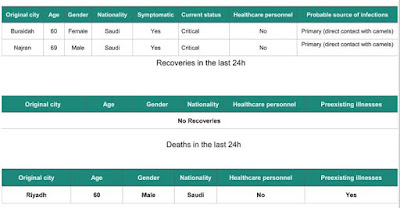#13,045
The Saudi MOH has, in the past few hours, posted two updates (Jan 8th & 9th) on their daily MERS reporting site, announcing 4 new cases and 1 death of a previously announced case from late December.
The fatal case - from Riyadh - was originally reported on December 28th, and listed in stable condition.Yesterday's Saudi MOH report shows two new primary (direct contact with camels) cases, one in Buraidah, and the other in Najran - along with the above mentioned fatality.
Today, 2 more cases were announced, 1 primary case (no listed exposure) in the Eastern Province, and 1 secondary HCW in Riyadh - both currently listed in stable condition.
Riyadh - since the first of the year - has admitted three locally acquired MERS cases, which appears the likely source of today's announced Health Care Worker's infection.
We've seen some very large nosocomial outbreaks in the past - sometimes involving hundreds of patients and HCWs across multiple facilities (see EID Journal: Large Hospital Outbreak Of MERS-CoV - Jeddah, Saudi Arabia, 2014).
Once common, over the past couple of years the Saudis appear to have gotten better at MERS infection control and have done a much better job of containing those hospital outbreaks that have occurred.In May-June of 2017, however, a 3-hospital outbreak in Riyadh produced 48 cases in less than a month (see chart below), with at least six fatalities.
More than half of the cases were listed as asymptomatic, discovered during the testing of contacts, which helps to explain the low case fatality rate (CFR).
Over the past couple of years we've seen a sharp rise in the number of asymptomatic MERS cases reported - possibly due to better contact testing (see Saudi MOH On KKUH MERS Outbreak & Increased Asymptomatic Detections).Exactly how much of a role asymptomatic carriers play in the spread of MERS remains a mystery, but it is worth noting that large nosocomial outbreaks (see here, here, and here) have been less common since the Saudis began to follow the WHO Guidance On The Management Of Asymptomatic MERS Cases in late 2015.
We'll be watching to see if that favorable trend continues in 2018.



